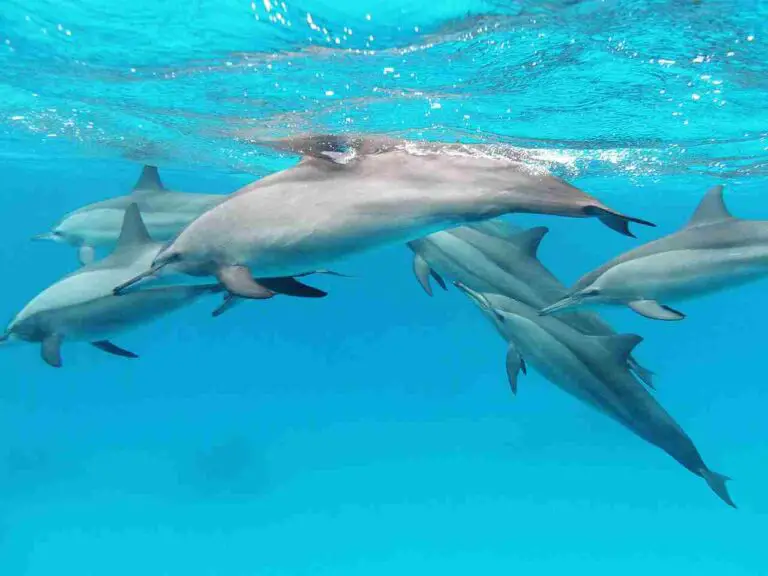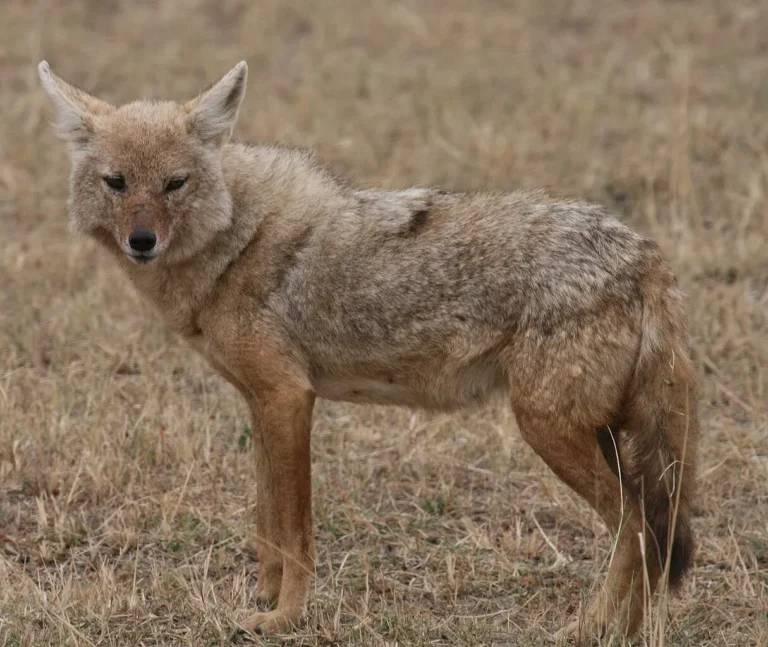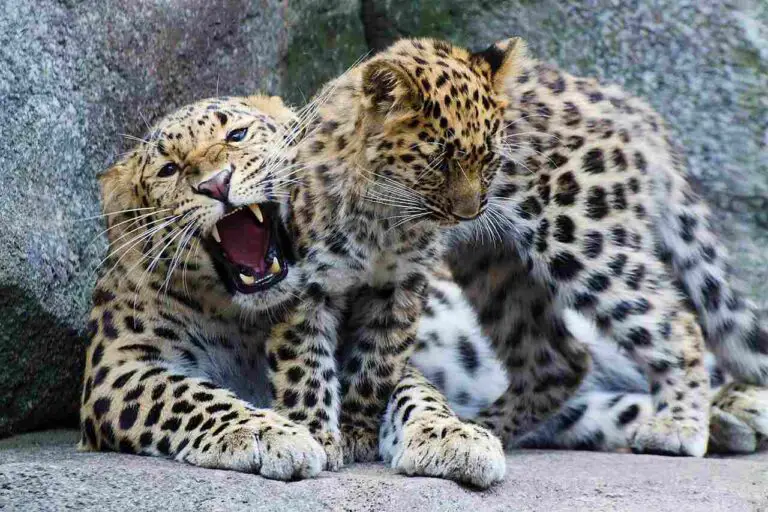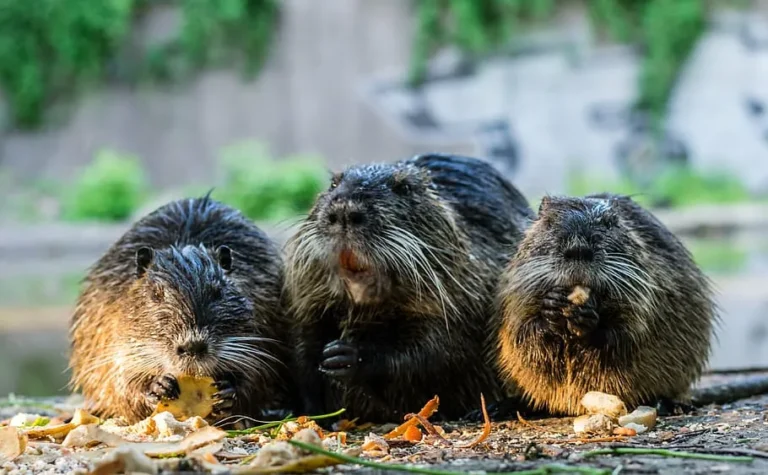Honey Badger Vs Komodo Dragon Who Will Win, and Overall Comparison
Honey badgers and Komodo dragons, fascinating members of the animal kingdom, each bring distinct characteristics to the table. The honey badger, known for its tenacity and agility, faces off against the Komodo dragon, a formidable reptile recognized for its sheer size, strength, and venomous capabilities. This analysis delves into their taxonomy, appearance, size, weight, agility, aggressiveness, venomous nature, and predatory features to speculate on the potential outcome of a one-on-one confrontation.
Honey Badger vs Komodo Dragon: Assessing the Likely Victor in a Confrontation
I). Size, Weight, and Strength:
– Komodo dragons, significantly larger and heavier than honey badgers, possess greater strength. This size and strength advantage allows Komodo dragons to exert dominance in a physical altercation, potentially overpowering the honey badger.
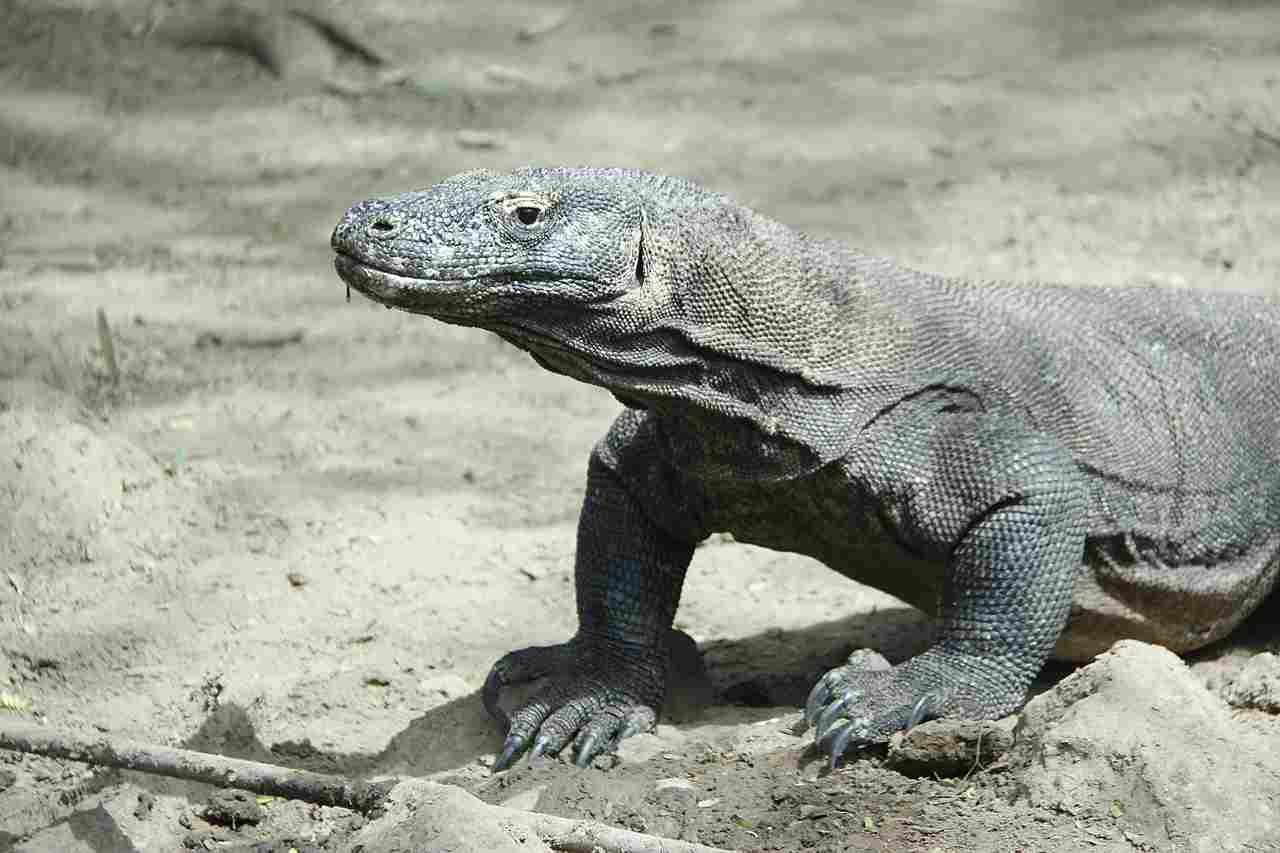
II). Venomous Nature:
– A critical factor favoring the Komodo dragon is its venomous bite. The presence of venom introduces a lethal aspect to the confrontation, giving the Komodo dragon an additional weapon that can be decisive in subduing the honey badger.
III). Agility of the Honey Badger:
– While Komodo dragons have size and strength on their side, honey badgers are known for their remarkable agility. The honey badger’s agility could enable it to evade some attacks, providing a means of survival in the face of the Komodo dragon’s formidable physical attributes.
IV). Aggressiveness:
– Both honey badgers and Komodo dragons are known for their aggressiveness, but the sheer size and strength of the Komodo dragon may give it an upper hand in a confrontational scenario.
V). Predatory Features:
– Komodo dragons are well-equipped predators with sharp claws, powerful jaws, and, most notably, venomous saliva. These features contribute to their effectiveness in hunting and can play a crucial role in a one-on-one battle.
VI). Overall Verdict:
– While honey badgers possess agility that could aid in survival, the Komodo dragon’s significant size, weight, strength, and venomous nature make it the likely victor in a confrontation. The honey badger’s ability to evade and its tenacity may prolong the encounter, but ultimately, the Komodo dragon’s formidable attributes position it as the dominant force in such a clash.
*Details of Comparison
| Criteria | Honey Badger | Komodo Dragon |
| Taxonomy | Kingdom: Animalia Phylum: Chordata Class: Mammalia Order: Carnivora Family: Mustelidae Genus: Mellivora Species: capensis |
Kingdom: Animalia Phylum: Chordata Class: Reptilia Order: Squamata Family: Varanidae Genus: Varanus Species: komodoensis
|
| Appearance | Compact body, coarse coat, white stripe |
Elongated, scaled skin, varied colors
|
| Size | 55-77 cm (body) + 25-30 cm (tail) | Up to 3 meters |
| Weight | 9-16 kg | 70-91 kg |
| Bite Force | Powerful bite, bone-crushing capability |
Sharp teeth, toxic saliva
|
| Physical Offensive Advantages | Sharp claws, powerful bite, tenacious |
Strong jaws, toxic saliva, ambush
|
| Physical Defensive Advantages | Thick skin, defensive behavior, burrowing |
Scaled skin, claws, territorial
|
| Speed | Up to 30 km/h | Up to 20 km/h |
| Agility | Highly agile, flexible body |
Agile for size, efficient movement
|
| Overall Physical Capacity | Compact, powerful physique |
Dominant force in the ecosystem
|
| Habitat Preference(s) | Diverse habitats, including suburbs |
Specific Indonesian islands
|
| Tracks | Padded footprints, claw marks |
Clawed tracks, reptilian features
|
| Lifespan | 7-8 years (wild) |
Up to 30 years (wild)
|
| Mode of Feeding | Omnivorous, raid beehives, diverse diet |
Carnivorous, large prey, scavenging
|
| Social Behavior | Mostly solitary, territorial |
Solitary, aggressive territoriality
|
| Mode of Reproduction | Viviparous, live young, 6 months gestation |
Oviparous, laying eggs, 8 months incubation
|
| Parental Behavior | Female raises cubs alone, maternal care |
Limited parental care, hatchlings fend for themselves
|
| Proximity to Human-Inhabited Areas | Tolerant, found in various habitats |
Limited to remote Indonesian islands
|
| Behavior Toward Humans | Generally aggressive when threatened |
Generally avoids humans, can be dangerous if provoked
|
| Danger Posed to Humans | Considerable danger in close encounters |
Potentially lethal, especially if provoked
|
| Associated Precautions | Caution required in the wild |
Strict guidelines for approaching
|
| Conservation Status | Least Concern | Vulnerable |
1. Taxonomy:
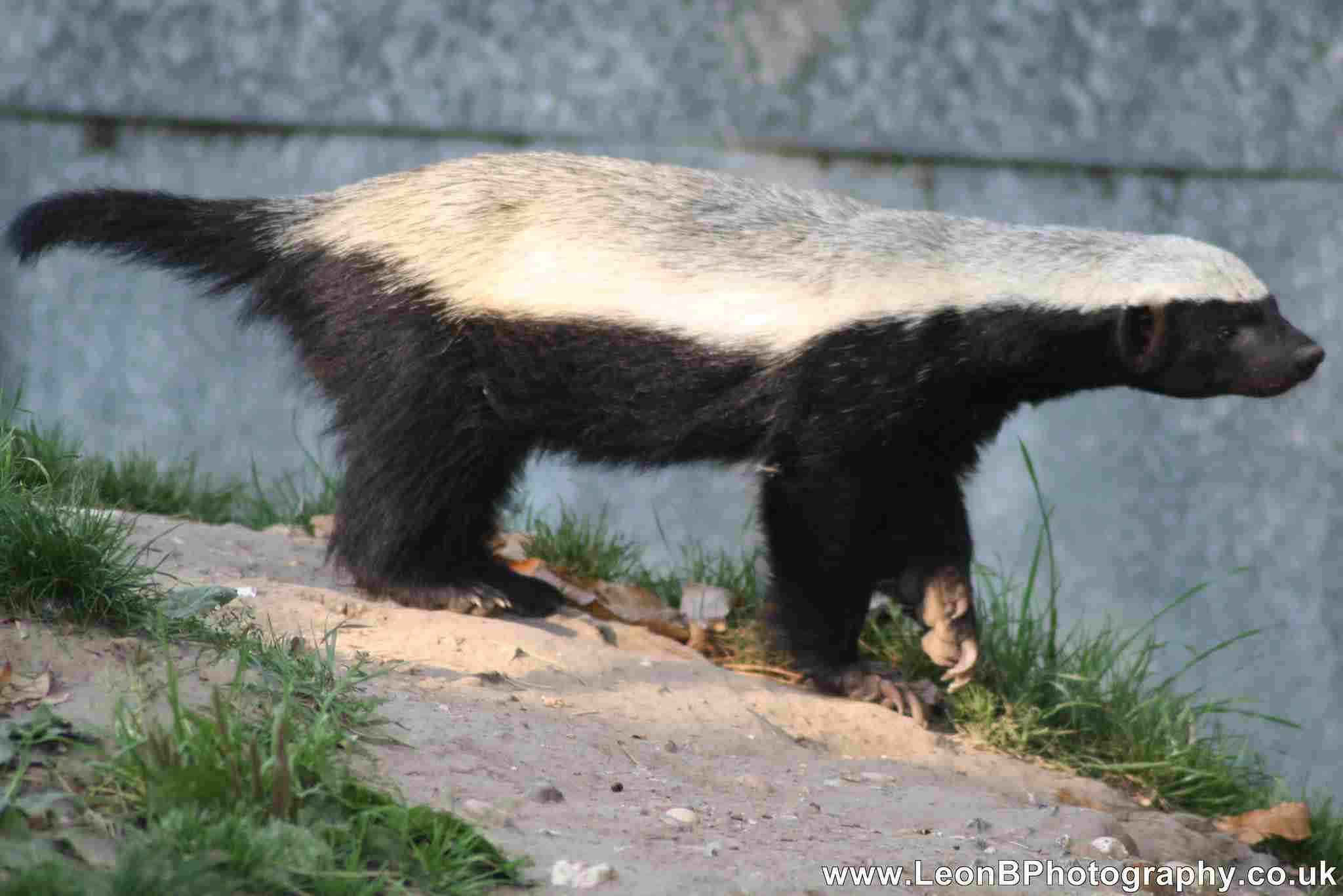
Honey Badger (Mellivora capensis):
Kingdom: Animalia
Phylum: Chordata
Class: Mammalia
Order: Carnivora
Family: Mustelidae
Genus: Mellivora
Species: capensis
Komodo Dragon (Varanus komodoensis):
Kingdom: Animalia
Phylum: Chordata
Class: Reptilia
Order: Squamata
Family: Varanidae
Genus: Varanus
Species: komodoensis
2. Appearance:
Honey Badger:
Compact, robust body with a flat back.
Thick skin with a coarse coat, often grey or black.
Distinctive white stripe on its back.
Ecological Implications:
Camouflage in various habitats.
Adaptation for burrowing and navigating diverse environments.
Komodo Dragon:
Elongated, muscular body with scaled skin.
Varied coloration, including earth tones.
Long, forked tongue for sensing surroundings.
Ecological Implications:
Blend into the Indonesian island landscape.
Scales provide protection and aid in thermoregulation.
3. Size:
Honey Badger:
Length: 55-77 cm (body), 25-30 cm (tail).
Comparison:
Smaller size, adapted for agility and burrowing.
Ecological Implications:
Suitable for accessing narrow spaces in various habitats.
Komodo Dragon:
Length: Up to 3 meters.
Comparison:
Larger size, apex predator in its ecosystem.
Ecological Implications:
Dominant predator, influences prey distribution.
4. Weight:
Honey Badger:
Typically 9-16 kg.
Comparison:
Relatively lightweight for a carnivore.
Ecological Implications:
Allows for agility and climbing abilities.
Komodo Dragon:
Adults can weigh 70-91 kg.
Comparison:
Heavier, reflecting its role as a top predator.
Ecological Implications:
Influences its position in the food chain.
5. Bite Force:
Honey Badger:
Strong bite for its size, able to crush bones.
Comparison:
Impressive bite force for a mammal.
Ecological Implications:
Enables consumption of a variety of prey.
Komodo Dragon:
Powerful bite with sharp, serrated teeth.
Comparison:
High bite force, delivering toxic saliva.
Ecological Implications:
Facilitates hunting and consuming large prey.
Note: Ecological implications refer to the role these characteristics play in the animals’ adaptation and interaction with their environment.
6. Physical Offensive Advantages:
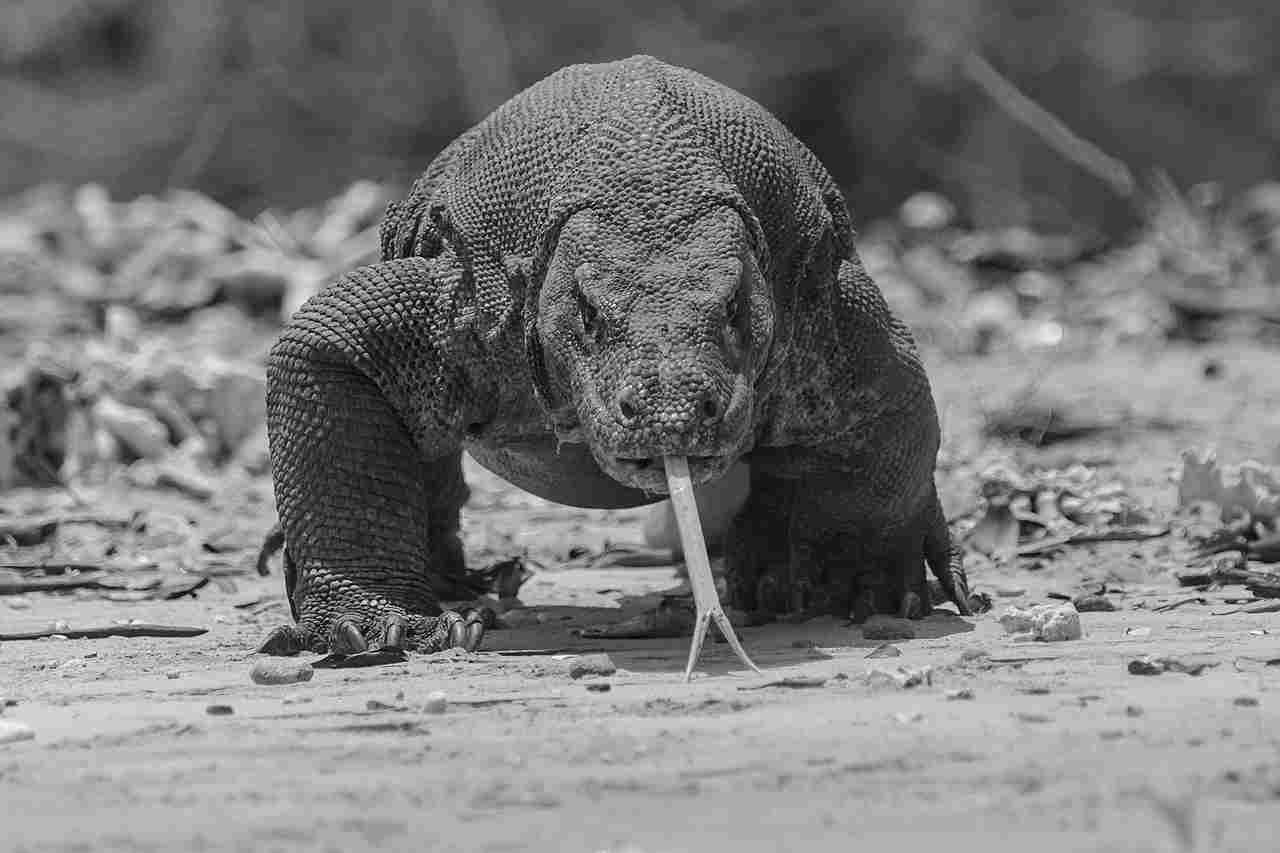
Honey Badger:
Sharp claws and powerful bite.
Fearless and tenacious nature.
Comparison:
Agile and ferocious in confrontations.
Ecological Implications:
Efficient at hunting and defending territory.
Komodo Dragon:
Strong jaws, serrated teeth, and toxic saliva.
Ambush hunting strategy.
Comparison:
Lethal combination of toxins and physical strength.
Ecological Implications:
Dominant predator, affecting local ecosystems.
7. Physical Defensive Advantages:
Honey Badger:
Thick, loose skin and strong defensive behavior.
Ability to escape into burrows.
Comparison:
Relies on toughness and agility for defense.
Ecological Implications:
Survives encounters with predators through resilience.
Komodo Dragon:
Tough, scaled skin.
Sharp claws and tail for defense.
Comparison:
Relies on physical attributes for protection.
Ecological Implications:
Minimizes vulnerability to other predators.
8. Speed:
Honey Badger:
Fast runners, capable of reaching 30 km/h.
Comparison:
Quick bursts of speed for evasion.
Ecological Implications:
Pursuing prey and escaping threats effectively.
Komodo Dragon:
Surprisingly fast for their size, reaching speeds of 20 km/h.
Comparison:
Speed contributes to successful hunting.
Ecological Implications:
Ambushing prey and covering ground efficiently.
9. Agility:
Honey Badger:
Highly agile with a flexible body.
Comparison:
Agile movements aid in climbing and hunting.
Ecological Implications:
Navigating varied landscapes with ease.
Komodo Dragon:
Agile for their size, enabling efficient movement.
Comparison:
Agility aids in capturing and subduing prey.
Ecological Implications:
Successful hunting in diverse environments.
10. Overall Physical Capacity:
Honey Badger:
Remarkable strength-to-size ratio.
Adapted for both offense and defense.
Comparison:
Compact and powerful physique.
Ecological Implications:
Versatility in adapting to different ecological niches.
Komodo Dragon:
Impressive physical prowess as a top predator.
Combines strength, speed, and agility.
Comparison:
Dominant force in its ecosystem.
Ecological Implications:
Influences the balance of the local food chain.
11. Habitat Preference(s):
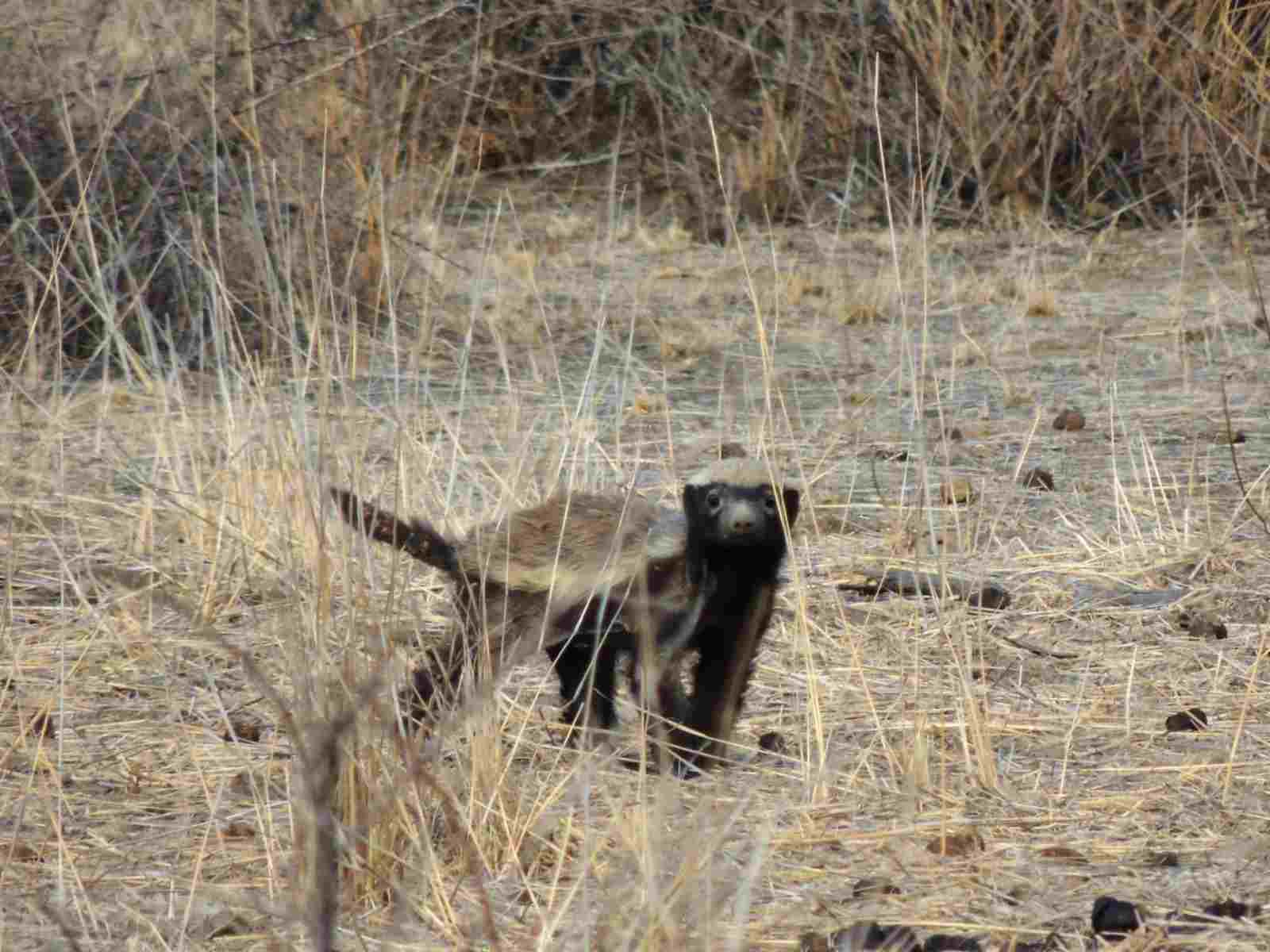
Honey Badger:
Diverse habitats, including grasslands and forests.
Prefers areas with access to water.
Comparison:
Wide-ranging habitat adaptation.
Ecological Implications:
Plays a role in various ecosystems.
Komodo Dragon:
Restricted to a few Indonesian islands.
Thrives in tropical forests and savannas.
Comparison:
Endemic to specific regions.
Ecological Implications:
Has a localized impact on its ecosystem.
12. Tracks:
Honey Badger:
Padded footprints with distinct claw marks.
Often shows signs of digging.
Comparison:
Reflects burrowing and digging behavior.
Ecological Implications:
Indicates territory exploration and hunting.
Komodo Dragon:
Clawed tracks with distinctive reptilian features.
Often seen near water sources.
Comparison:
Marks indicate reptilian movement patterns.
Ecological Implications:
Tracked movement tied to hunting strategies.
13. Lifespan:
Honey Badger:
Typically 7 to 8 years in the wild.
Comparison:
Shorter lifespan for a mammal.
Ecological Implications:
Rapid turnover in population dynamics.
Komodo Dragon:
Can live up to 30 years in the wild.
Comparison:
Longer lifespan for a reptile.
Ecological Implications:
Influences the stability of the local ecosystem over time.
14. Mode of Feeding:
Honey Badger:
Omnivorous diet, including small mammals, insects, and plant matter.
Known for raiding beehives for honey.
Comparison:
Generalist feeder with a diverse diet.
Ecological Implications:
Affects prey and plant populations in its habitat.
Komodo Dragon:
Carnivorous diet, feeding on large prey like deer and water buffalo.
Capable of scavenging and hunting.
Comparison:
Specialized carnivore with a preference for larger prey.
Ecological Implications:
Influences local herbivore populations.
15. Social Behavior:
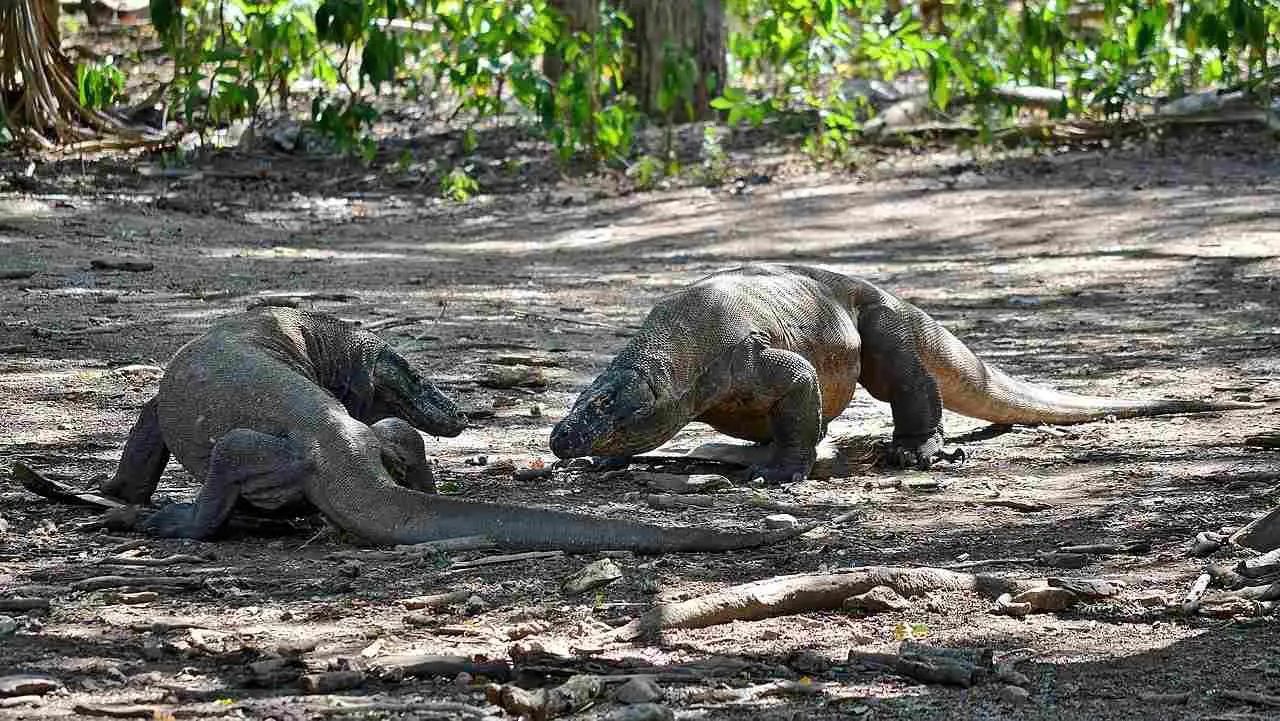
Honey Badger:
Mostly solitary, with occasional interactions during mating.
Territorial and aggressive when confronted.
Comparison:
Primarily a solitary lifestyle.
Ecological Implications:
Maintains individual territories, reducing competition.
Komodo Dragon:
Solitary animals, coming together primarily for mating.
Aggressive territorial behavior.
Comparison:
Independent and territorial nature.
Ecological Implications:
Individual territories affect prey distribution.
16. Mode of Reproduction:
Honey Badger:
Viviparous reproduction, giving birth to live young.
Gestation period around 6 months.
Comparison:
Mammalian reproductive strategy.
Ecological Implications:
Low reproductive rate influences population dynamics.
Komodo Dragon:
Oviparous reproduction, laying eggs in nests.
Incubation period around 8 months.
Comparison:
Reptilian reproductive strategy.
Ecological Implications:
Higher reproductive output but vulnerable eggs.
17. Parental Behavior:
Honey Badger:
Females raise their cubs alone.
Maternal care involves teaching hunting and survival skills.
Comparison:
Female-centric parental care.
Ecological Implications:
Promotes individual learning and self-sufficiency.
Komodo Dragon:
Limited parental care after egg-laying.
Hatchlings are left to fend for themselves.
Comparison:
Minimal parental involvement.
Ecological Implications:
Higher vulnerability of offspring to predation.
18. Proximity to Human-Inhabited Areas:
Honey Badger:
Can be found in various habitats, including suburban areas.
May raid garbage bins and farms.
Comparison:
Tolerant of human presence in diverse landscapes.
Ecological Implications:
Human interactions can influence behavior and diet.
Komodo Dragon:
Limited to specific islands in Indonesia, away from urban areas.
Minimal direct interaction with human settlements.
Comparison:
Endemic to remote regions with lower human impact.
Ecological Implications:
Natural behaviors less influenced by human activities.
19. Behavior Toward Humans:
Honey Badger:
Generally aggressive and fearless when confronted.
Can be a nuisance in areas with human populations.
Comparison:
May display confrontational behavior when feeling threatened.
Ecological Implications:
Human interactions may lead to alterations in behavior.
Komodo Dragon:
Typically avoids direct confrontation with humans.
Can be dangerous if provoked or threatened.
Comparison:
Generally less confrontational than honey badgers.
Ecological Implications:
Limited impact on local human activities.
20. Danger Posed to Humans:
Honey Badger:
Can be dangerous when cornered or provoked.
Known for its tenacious and aggressive nature.
Comparison:
Considerable danger in close encounters.
Ecological Implications:
Humans may need to take precautions in shared habitats.
Komodo Dragon:
Generally avoids humans but can be aggressive if threatened.
Bites can be lethal due to toxic saliva.
Comparison:
Potentially lethal, especially if provoked.
Ecological Implications:
Human safety measures are essential in their habitats.
21. Associated Precautions:
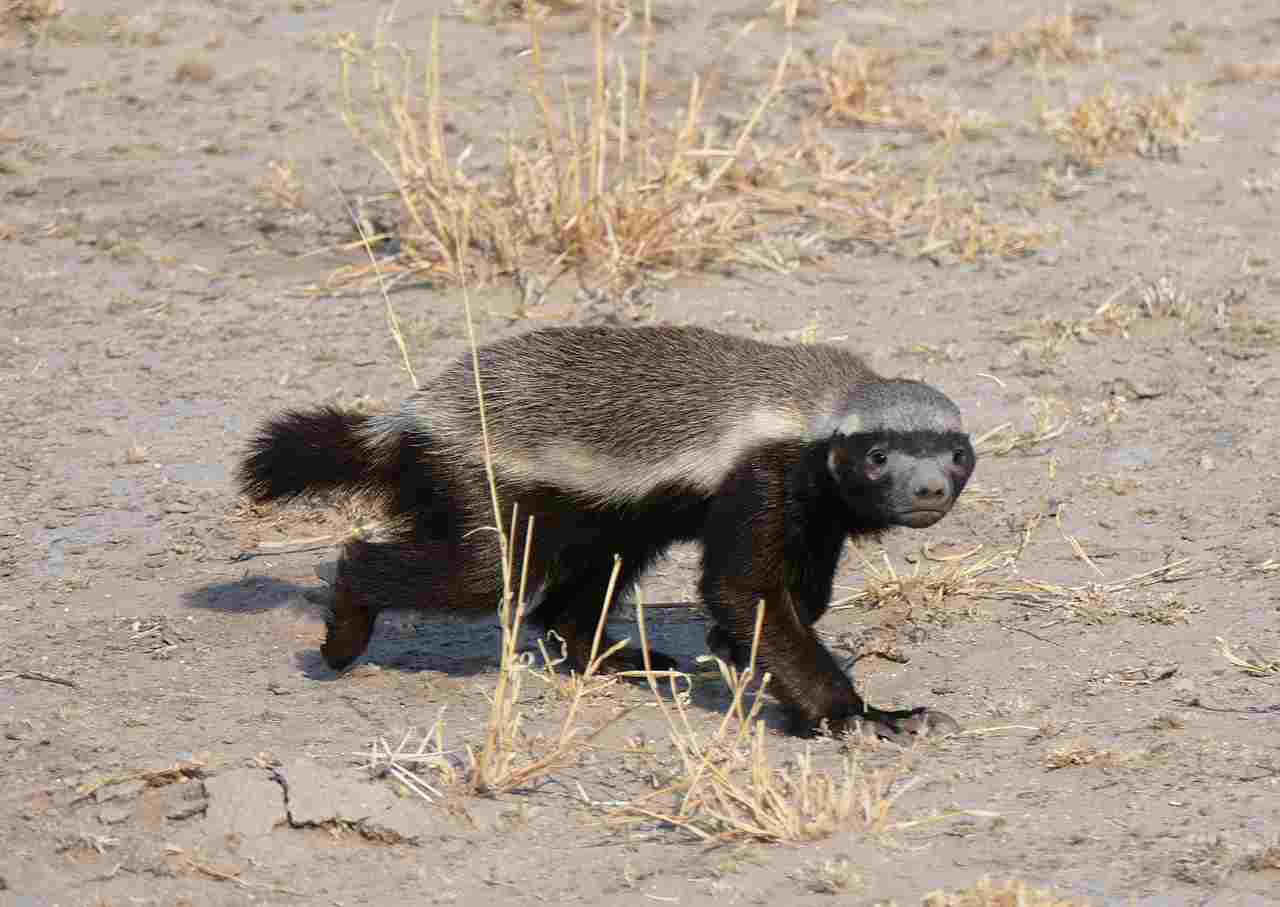
Honey Badger:
Caution required when encountering in the wild.
Avoidance of confrontational situations recommended.
Comparison:
Vigilance needed for safety.
Ecological Implications:
Human awareness can minimize conflicts.
Komodo Dragon:
Strict guidelines for approaching in the wild.
Controlled tourism to reduce disturbance.
Comparison:
More stringent precautions due to potential danger.
Ecological Implications:
Tourism impact on behavior and habitats considered.
22. Conservation Status:
Honey Badger:
Generally classified as “Least Concern” by the IUCN.
Populations are relatively stable.
Comparison:
Currently not considered a species of immediate concern.
Ecological Implications:
The stable population suggests a balanced ecosystem.
Komodo Dragon:
Classified as “Vulnerable” by the IUCN.
Facing threats from habitat loss and poaching.
Comparison:
Higher conservation concern due to vulnerability.
Ecological Implications:
A decline in their numbers could impact local ecosystems.
Summary of Comparison
Taxonomy:
Honey Badger: Mammal (Mustelidae).
Komodo Dragon: Reptile (Varanidae).
Appearance:
Honey Badger: Compact, coarse coat, white stripe.
Komodo Dragon: Elongated, scaled skin, varied colors.
Size:
Honey Badger: 55-77 cm (body) + 25-30 cm (tail).
Komodo Dragon: Up to 3 meters.
Weight:
Honey Badger: 9-16 kg.
Komodo Dragon: 70-91 kg.
Bite Force:
Honey Badger: Powerful bite, bone-crushing capability.
Komodo Dragon: Sharp teeth, toxic saliva.
Physical Offensive Advantages:
Honey Badger: Sharp claws, powerful bite, tenacious.
Komodo Dragon: Strong jaws, toxic saliva, ambush.
Physical Defensive Advantages:
Honey Badger: Thick skin, defensive behavior, burrowing.
Komodo Dragon: Scaled skin, claws, territorial.
Speed:
Honey Badger: Up to 30 km/h.
Komodo Dragon: Up to 20 km/h.
Agility:
Honey Badger: Highly agile, flexible body.
Komodo Dragon: Agile for size, efficient movement.
Overall Physical Capacity:
Honey Badger: Compact, powerful physique.
Komodo Dragon: Dominant force in the ecosystem.
Habitat Preference(s):
Honey Badger: Diverse habitats, including suburbs.
Komodo Dragon: Specific Indonesian islands.
Tracks:
Honey Badger: Padded footprints, claw marks.
Komodo Dragon: Clawed tracks, reptilian features.
Lifespan:
Honey Badger: 7-8 years (wild).
Komodo Dragon: Up to 30 years (wild).
Mode of Feeding:
Honey Badger: Omnivorous, raid beehives, diverse diet.
Komodo Dragon: Carnivorous, large prey, scavenging.
Social Behavior:
Honey Badger: Mostly solitary, territorial.
Komodo Dragon: Solitary, aggressive territoriality.
Mode of Reproduction:
Honey Badger: Viviparous, live young, 6 months gestation.
Komodo Dragon: Oviparous, laying eggs, 8 months incubation.
Parental Behavior:
Honey Badger: Female raises cubs alone, maternal care.
Komodo Dragon: Limited parental care, hatchlings fend for themselves.
Proximity to Human-Inhabited Areas:
Honey Badger: Tolerant, found in various habitats.
Komodo Dragon: Limited to remote Indonesian islands.
Behavior Toward Humans:
Honey Badger: Generally aggressive when threatened.
Komodo Dragon: Generally avoids humans, can be dangerous if provoked.
Danger Posed to Humans:
Honey Badger: Considerable danger in close encounters.
Komodo Dragon: Potentially lethal, especially if provoked.
Associated Precautions:
Honey Badger: Caution required in the wild.
Komodo Dragon: Strict guidelines for approaching.
Conservation Status:
Honey Badger: Least Concern.
Komodo Dragon: Vulnerable.
Conclusion
I. Similarities:
Both exhibit impressive physical capabilities.
Solitary in nature, with limited social interactions.
Have specific modes of reproduction (viviparous for honey badgers, oviparous for Komodo dragons).
II. Differences:
Divergent taxonomic classifications (mammal vs. reptile).
Varied habitat preferences (widespread for honey badgers, endemic for Komodo dragons).
Distinctive parental care strategies (female-centric for honey badgers, minimal for Komodo dragons).
Contrasting conservation statuses (Least Concern for honey badgers, Vulnerable for Komodo dragons).
